|
Antiquities
I've never been much enamored of antiques. Your standard antique reminds me
too much of the stuff that was all around me when I was growing up. At
the risk of betraying my age, I can tell you honestly that they
weren't classified as antiques back then -- just worn-out old hand-me-downs. You
have to talk about real antiques -- truly ancient artifacts -- before I start
to get interested.
The items we've collected in this genre are the everyday objects that common
people owned. They are the flotsam and jetsam of normal economic and
domestic life, articles that even the lowliest peasant would have in his
domicile. Items that end up laying scattered around in the dirt by the
thousands when
civilizations disappear. And basically, the only antiquities we can
afford to buy!
It's easy to see that real art and care went into the making of these simple
objects. They're not like the cold, mass-produced plastic or
nickel-plated, stamped-out crap that you get nowadays. There's a lot of
love embedded in their craftsmanship; it's inherent in them and it lasts forever.
You can literally feel it when
you handle them.
What common articles do we have in our own homes today that could be held
up to this standard, hundreds of years from now? I can't think of many
objects that would even survive that long, ephemeral as they are. Our
porcelain toilets would certainly weather the assault of deep-time -- but I
would judge that there's not much artistic merit in that particular domestic
accoutrement. Is that the best we can offer to future
archeologists?
Click on the thumbnail images below to see a larger picture, then click
your browser's "back" button to return to this page.
Pre-Columbian Articles
 |
Terracotta pot, carinated-shaped
tripod with pronounced upper lip, El Bosque red on buff, incised, with
clay appliques (salamanders?), 1-7/8" tall. Costa Rica, Central
Highlands/Atlantic Watershed region, 100 B.C – 500 A.D (Period IV). |
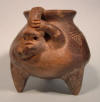 |
Terracotta pot, tripod legs,
incised patterns, 2-5/8" tall. Handles in the form of a human nose with
hands around it -- very whimsical! Costa Rica, 100 B.C – 500 A.D. |
 |
Clay roller stamps, 1" tall and
2-1/4" tall. Used for making decorative impressions in wet clay strips.
Mayan, 1000-1500 A.D. |
 |
Clay whorl, 1-1/8" tall by 1-3/4"
diameter. Used for spinning thread or yarn. Colombia (Quimbaya),
1000 – 1500 A.D. |
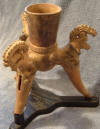
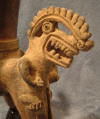 |
Terracotta tripod Chocolate Pot,
11" tall. This particular type was used as a funerary vessel for burnt
offerings. Fierce-looking reptilian creature on top of each leg. Clay
rattle beads inside legs. Costa Rica Atlantic Watershed region, 500-1000
A.D. The pride of our collection, damaged though it may be. |
 |
Terracotta bowl, 3-1/2" tall
by 5-3/4" diameter. Panama (Cocle), 500-1000 A.D. Gorgeous
decorative style, typical of all Cocle articles. Heavy manganese
encrustations, which take centuries to form, mark this piece as
authentic. It came dearly. |
 |
Terracotta vessels, 3" to 4" tall,
decorated. Mexico (Jalisco), ca. 300 A.D. Dubious
provenance, likely forgeries. |
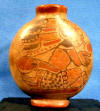 |
Clay Flask, 6" tall, Mayan,
600-900 A.D. Possible forgery, but a darned good one if it is!
Would have had a leather thong tied around its neck to allow it to be
carried around. |
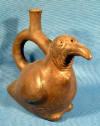 |
Clay blackware bird (vulture?)
vessel, 8" tall. Hanging hookhole in snout. Peru (Chancay),
1000 - 1400 A.D. Hole in one eye, possibly there to equalize air
pressure when drinking from the spout. Match your everyday plastic
drinking tumblers to this guy! |
 |
Clay bird (duck?)
vessel, 6" tall. Some original painted decoration survives.
Peru, 1200-1450 A.D. |
Other Articles
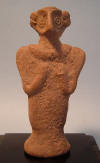 |
Clay columnar idol, 4"
tall. Northern Syria, 2500 - 2000 B.C. |
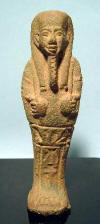 |
Faience shabti figure,
4" tall. Egypt,
Late Kingdom, 26th
Dynasty, 663 - 525 B.C. See
this linked page for more details. |
 |
Clay spouted vessel,
3-1/2" tall. Mesopotamia, 200 B.C. |
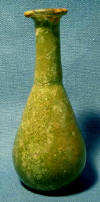 |
Glass bottle, 6-1/2"
tall, Roman, 100 - 200 A.D. |
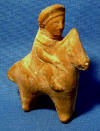 |
Clay figure, 5-3/4"
tall. Phoenecian, 300 A.D. Possible a child's toy? |
Back to Collections...
NOTE: To the best of my knowledge,
these items were legally obtained. Almost all were bought from reputable
antiquities dealers, with proper legal provenance. Because so many of
the items exist, there is nothing particularly rare or of archeological
value here. (Surely by now, every museum that wants one, has one.)
Regardless, in my view many of the laws covering import prohibitions on these
kinds of items are based simply on politics, institutional greed and
sovereign pomposity.
Are any of these items modern forgeries?
Probably so. A "certificate of authenticity" from the seller simply
means that you can get your money back if you can prove it's a forgery.
Good forgeries are hard to detect, and there is big money, and thus high
motivation, in doing your forgeries well. Knowing this, I can take
solace only in figuring that the percentage of forgeries in our little
collection is likely no higher than what you will find in any ordinary museum.
(I've read that you can put a nice ancient patina on a small forgery by
passing it through a goat or a cow, from front end to rear!)
|
